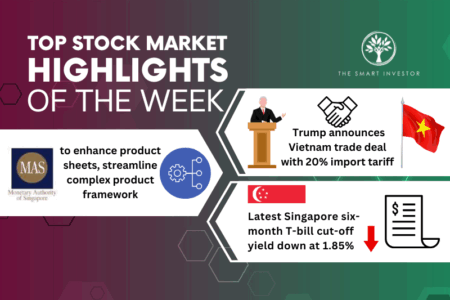With the earnings season rolling on, investors are closely scrutinising companies’ latest results to see how these businesses have performed.
The blue-chip sector is of particular interest as this group of companies has a strong track record of weathering different economic conditions.
The good news is that most of the blue-chip stocks also pay out a dividend, which helps income-seeking investors generate a useful stream of passive income.
We highlight four blue-chip stocks that managed to increase their dividends this earnings season.
Mapletree Industrial Trust (SGX: ME8U)
Mapletree Industrial Trust, or MIT, is an industrial REIT with a portfolio of 56 properties in the US, 83 properties in Singapore, and one in Japan.
The REIT’s assets under management stood at S$9 billion as of 30 June 2024.
MIT released its financial results for the first quarter of fiscal 2025 (1Q FY2025) ending 30 June 2024.
Gross revenue rose 2.7% year on year to S$175.3 million, aided by revenue contributions from the REIT’s latest Osaka data centre acquisition along with new leases and renewals across other property sectors.
Net property income inched up 1.3% year on year to S$132.5 million.
Distribution per unit (DPU) increased by 1.2% year on year to S$0.0343.
The industrial REIT maintained a high portfolio occupancy rate of 91.9% which was higher than the previous quarter’s 91.4%.
In addition, MIT also reported an average positive rental reversion of 9.2% for renewal leases.
The REIT’s aggregate leverage stood at 39.1%, giving it ample room to rely on debt financing for further accretive acquisitions.
Singapore Exchange Limited (SGX: S68)
Singapore Exchange Limited, or SGX, is Singapore’s sole stock exchange operator.
The group reported an encouraging set of earnings for its fiscal 2024 (FY2024) ending 30 June 2024.
Revenue increased by 3.1% year on year to S$1.2 billion, aided by higher revenue from the Currencies and Commodities division and Platform and Others.
Net profit improved by 4.7% year on year to S$597.9 million.
The bourse operator upped its quarterly dividend from S$0.085 to S$0.09, taking its annualised dividend to S$0.36 from S$0.34.
For its Currencies and Commodities division, revenue grew by 22.3% year on year to S$322.5 million.
Derivatives daily average volume (DAV) rose from one million to 1.1 million in FY2024 while its OTC (over-the-counter) foreign exchange (FX) platform saw a 46% year-on-year surge in headline average daily volume to US$111 billion.
Management hopes to grow the group’s revenue by between 6% to 8% every year in the medium term.
To do so, SGX plans to implement a whole-of-ecosystem approach to strengthen the equities market in Singapore.
It will also work on enhancing connectivity across ASEAN by forging partnerships and collaborations.
OCBC Ltd (SGX: O39)
OCBC is Singapore’s second-largest bank and offers a comprehensive suite of banking, insurance, and investment services.
The lender released a sparkling set of earnings for the first half of 2024 (1H 2024).
Net interest income rose 3% year on year to S$4.9 billion.
Along with a 15% year-on-year increase in non-interest income, OCBC’s total income improved by 7% year on year to S$7.3 billion.
The group’s net profit came in 9% higher than the previous year at S$3.9 billion.
In line with the strong results, OCBC raised its interim dividend by 10% year on year from S$0.40 to S$0.44.
Although the bank’s net interest margin dipped from 2.28% in 1H 2023 to 2.23% in 1H 2024, net interest income was buoyed by an increase in average assets by 5% year on year.
OCBC’s wealth management division also did well, posting a 14% year-on-year increase in wealth management income to S$2.5 billion.
Wealth management assets under management crept up 2% year on year to S$279 billion.
CEO Helen Wong believes that the bank is firmly on track to meet its 2024 targets.
She expects the net interest margin to be in the range of 2.2% to 2.25% with a low-single-digit loan growth.
Sembcorp Industries Ltd (SGX: U96)
Sembcorp Industries, or SCI, is an energy and urban solutions provider with a balanced energy portfolio of 21.2 GW across 10 countries.
The group also has urban development projects spanning 14,000 hectares across Asia.
Revenue for 1H 2024 fell by 12% year on year to S$3.2 billion.
The lower revenue can be attributed to downtime from major maintenance for SCI’s Singapore cogeneration plant along with lower wholesale prices.
Net profit edged up 2% year on year to S$540 million.
However, net profit excluding exceptional items was down 12% year on year to S$532 million.
Despite the weaker result, SCI increased its interim dividend from S$0.05 to S$0.06.
SCI has grown its renewable capacity steadily over the years, with capacity quadrupling from 3.2 GW in 2020 to 12.9 GW in 2023.
Gross renewables capacity stood at 14.4 GW as of June 2024 and management’s target is for this number to hit 25 GW by 2028.
Meanwhile, the group also released a strategic plan for its urban development division.
By 2028, SCI hopes to have 18,000 hectares of land for development, up from 14,000 at present.
The group also targets to increase its industrial properties’ gross floor area from around 130,000 square metres to 1.5 million square metres.
Which SGX companies will reach S$100 billion next? Our latest FREE report provides detailed financial analysis and growth prospects of 5 potential candidates. The results? Surprising. You’ll want to grab a copy now and see whether what everyone else says is true. Click here to download now.
Follow us on Facebook and Telegram for the latest investing news and analyses!
Disclosure: Royston Yang owns shares of Mapletree Industrial Trust and Singapore Exchange Limited.





